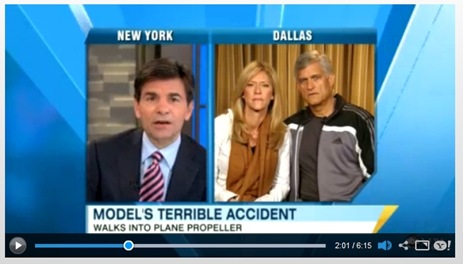Night landings, takeoffs and approaches can be a tricky business even for experienced pilots as two summaries of recent National Transportation Safety Board (NTSB) accident reports from General Aviation news reveal. The first accident report from September 2009 covered an incident that resulted in one minor injury and a heavily damaged Cessna 172 in Minnesota.
According to the accident report, the pilot was attempting to land at night in VFR conditions and he performed a go-around on the first attempt. For the second attempt, he landed mid-field and performed a touch-and-go landing with 10° of flaps on takeoff which he retracted when he reached about 100 feet above ground level. However:
He felt that the airspeed was a little low so he pushed the nose over. He stated that he did not think he was in a descent, but the airplane hit the ground about 100 feet from the end of the runway.
The impact caused the nose gear to collapse and both wings were also damaged. An investigation of the accident site revealed eight ground scars in the grass that were consistent with propeller strikes while the pilot himself had about 112 hours of flight time with 9 hours at night (including two hours of night experience when he was pilot-in-command). Hence, the pilot’s failure to maintain a proper climb rate during a night takeoff was ruled the cause of the accident.
The second NTSB accident report also dated September 2009 involved a Cessna 210 in Texas where there was one fatality. The pilot had 1,276 total hours which included 475 hours in the same make and model airplane plus he had landed five times at the airport where the accident occurred.
However and this time around, he was attempting to land in dark night conditions with visibility at 3 to 5 miles in drizzle or light rain with overcast clouds. Moreover, the airport was a private rural airport whose lighting system was inoperable due to a recent lightening strike. Hence, a local resident radioed the pilot to inform him of this while another resident attempted to illuminate the runway with the headlights from a car.
According to witnesses, the pilot was not aligned with the runway and also appeared to be too high to land. The pilot radioed at 50 to 150 feet that he would perform a go-around but instead the aircraft began a descent, hit trees on the edge of the runway and then crashed into an empty house.
The investigation ruled that night and poor weather conditions meant that spatial disorientation was the probable cause of the accident as the FAA’s “Instrument Flying Handbook” (FAA-H-8083-15A) states that:
A rapid acceleration…can create the illusion of being in a nose up attitude. The disoriented pilot will push the aircraft into a nose low, or dive attitude.
In other words and if you plan to do any night flying, it would be a good idea to keep these incidents in mind.
